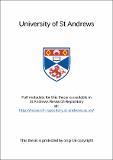Generation and characterisation of ultrashort diode laser pulses
Abstract
This thesis is concerned with the development of a compact diode laser source of picosecond optical pulses having enhanced average powers. This is realised by the application of a large amplitude sinusoidal modulation to a single-contact, single-mode, narrow stripe, InGaAs/GaAs ridge-waveguide diode laser. The operational characteristics of the device when in continuous wave and gainswitched regimes are presented.
In the gain-switched regime, a minimum pulse duration of 30ps is demonstrated, at average and peak powers up to ≈150mW and ≈1.8W respectively. A sonogram technique is employed to determine the sign and magnitude of the frequency chirp in the optical pulses. On the basis of this information aperiodic gratings are designed and fabricated in germanosilicate optical fibres and lithium niobate crystals to realise temporal pulse compression and efficient second harmonic generation respectively.
The effect of self-injection optical feedback is described, along with the corresponding realisation in the reduction in the spectral bandwidth of the optical pulses from ≈11nm to 0.05nm. When the optical feedback is provided by a standard diffraction grating, a tuning range of 70nm is demonstrated. The addition of a second grating results in two independently tunable outputs, with an adjustable spectral separation of up to 53nm.
Bragg gratings are fabricated in the cores of photosensitive germanosilicate optical fibres. It is demonstrated that when such a fibre is used in an external cavity configuration, both temporal and spectral compression of the optical pulses is observed. Direct frequency conversion of the diode laser output by using quasi-phase matched crystals of lithium niobate and KTP is demonstrated. High efficiencies are obtained with a KTP crystal containing a waveguide structure and a Bragg grating section to provide optical feedback to the diode laser. By this approach impressively high average second harmonic powers of up to 7.3mW in the blue spectral region are achieved for this frequency-doubled picosecond diode laser.
Type
Thesis, PhD Doctor of Philosopy
Collections
Items in the St Andrews Research Repository are protected by copyright, with all rights reserved, unless otherwise indicated.

